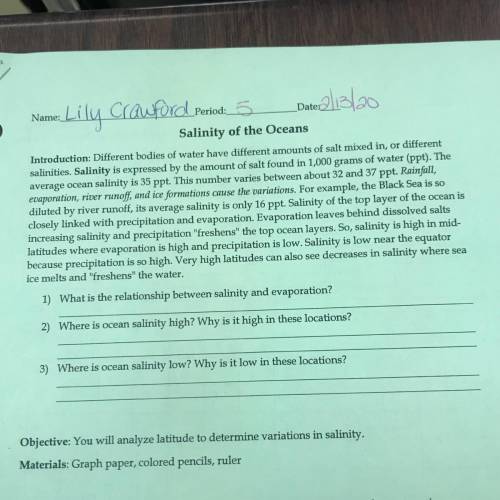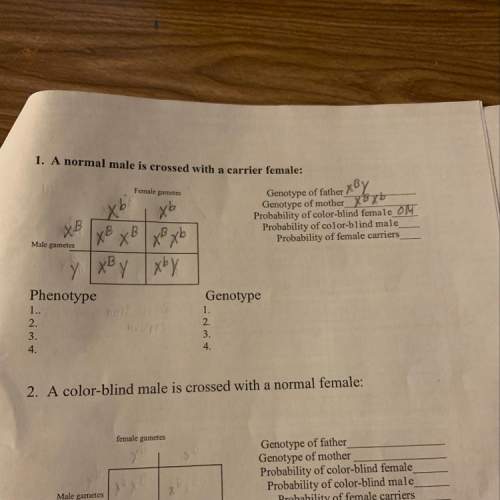Salinity of the Oceans
Introduction: Different bodies of water have different amounts of salt...

Biology, 13.02.2020 19:37 592400014353
Salinity of the Oceans
Introduction: Different bodies of water have different amounts of salt mixed in, or different
salinities. Salinity is expressed by the amount of salt found in 1,000 grams of water (ppt). The
average ocean salinity is 35 ppt. This number varies between about 32 and 37 ppt. Rainfall,
evaporation, river runoff, and ice formations cause the variations. For example, the Black Sea is so
diluted by river runoff, its average salinity is only 16 ppt. Salinity of the top layer of the ocean is
closely linked with precipitation and evaporation. Evaporation leaves behind dissolved salts
increasing salinity and precipitation "freshens" the top ocean layers. So, salinity is high in mid-
latitudes where evaporation is high and precipitation is low. Salinity is low near the equator
because precipitation is so high. Very high latitudes can also see decreases in salinity where sea
ice melts and "freshens" the water.
1) What is the relationship between salinity and evaporation?
2) Where is ocean salinity high? Why is it high in these locations?
3) Where is ocean salinity low? Why is it low in these locations?


Answers: 1


Other questions on the subject: Biology

Biology, 21.06.2019 15:30, lazybridplayer
Rank the three variables in terms of how strongly they affect the "species" composition of the bacterial communities. place the variable with the weakest effect on the left and the variable with the strongest effect on the right.
Answers: 2

Biology, 21.06.2019 21:20, cxndii13
Indicate whether the following statements about the biases in the fossil record are true or false. a) inland species are more likely to be preserved than marine species b) organisms with hard body parts are more likely to be preserved than are those composed soft tissues. c) species that existed over a larger area are more likely to be preserved than species existing over a smaller area. d) organisms that lived very long ago are more likely to be found as fossils than organisms that lived relatively recently e) the fossils of larger organisms are more likely to be found than the fossils of smaller organisms
Answers: 2

Biology, 22.06.2019 08:10, Haneendye123
In sweet pea, gene c is responsible for color production and gene p is responsible for the purple color pigment. both of them are located on two different loci on different chromosomes. the flowers will be purple only when the plant has the genotypes as c_p_. no color will be produced with genotypes: ccpp, ccpp, ccpp, ccpp. thus, gene c controls the expression of gene p. what pattern of inheritance is exhibited here? a. pleiotropy b. epistasis c. multiple alleles
Answers: 1

Biology, 22.06.2019 12:30, GaryCarmine
If a cell is placed into a hypertonic environment, what will happen to it ? a)it will shrink or shrivel b)nothing c)it will burst d) it will expand or enlarge
Answers: 1
You know the right answer?
Questions in other subjects:


Mathematics, 05.11.2020 21:10


Health, 05.11.2020 21:10

Mathematics, 05.11.2020 21:10

Mathematics, 05.11.2020 21:10



Biology, 05.11.2020 21:10

Mathematics, 05.11.2020 21:10




